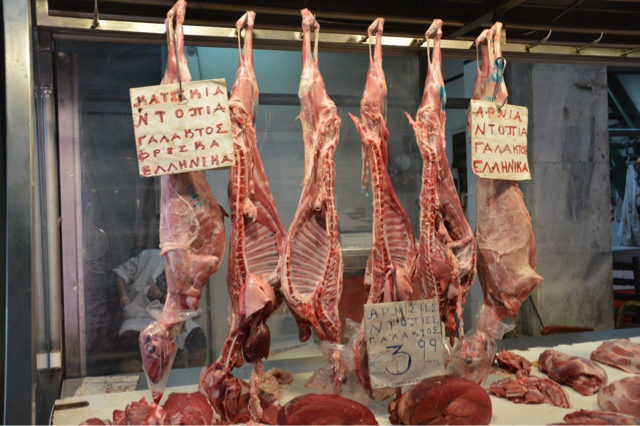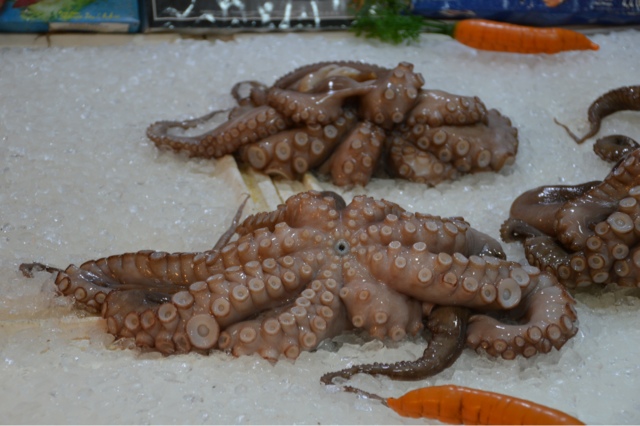Once we arrived downtown, we took a nice walk throughout the city center to a small Greek cafe where we had our cooking lesson for the day.
Maria (pictured above holding a grape leaf) welcomed us to her family's restaurant and explained popular ingredients in Greek food. The most important ingredient into any recipe is love, as good food is made for family and friends. Eating is considered to be a social time in the eyes of the Greeks. Our group split into 4 teams and had a chance to rotate through all of the stations.
The above photos are of the baked potatoes made with mustard, which was paired with the beef burgers (almost like a meatloaf) called Beef Bitteki (pictured below).
The third station were the grape leaves filled with rice and herbs called Dolmadakia Gialantzi with vine leaves (pictured below).
The last and final station was the traditional Greek salad along with the appetizer called Tzatziki, a dipping sauce used as an appetizer. Greeks sure do love olive oil! They used olive oil in all of the recipes, and they buy it by the barrel! The traditional Greek salad is basically cut up tomatoes, cucumbers, red onions, and olive oil with herbs.
After our cooking lesson, we were able to indulge in the fruits of our labor by eating our new foods for lunch! Everything was absolutely delicious! Everyone in our group was given a copy of the new Greek recipes as well as a certificate of completion for our Greek cooking course.
After lunch we had a city tour of Athens which started with walking through a traditional meat and fish market so students could get a feel of what shopping for the locals was like in Greece. It was surely different than our butcher shops/stores at home! Below are some of the meats and fish we saw walking through the market.
Our next stop was to see the original city wall of Athens as well as the entrance gate from 500 BC.
Next we hoppe aboard the happy train to cruise through town to see other important sites of Athens.
We stopped at the Parliament where we were able to stand with the guards for a picture. The guards do not get paid, but it is considered to be an honor to serve in this capacity for your country. Those chosen to be guards must be good looking since the public will be taking lots of pictures, and the men must be at least 6 feet tall. Each of these guards serves in one hour increments between two and
We arrived at the Acropolis for a guided tour, and we climbed up to the top to learn about this important site and see an amazing view of the city.
The word "Acropolis" can be broken down to "acro" meaning top, and "polis" meaning city, which is the hill in which the city sits upon. The famous building at the top is called the Parthenon, which is known as the perfect building. It is perfect for two reasons: 1) it was built using the "Golden Rule," which is a set of measurements that represents harmony, and 2) the building covers the problem of perspective- how you can see the building. From far away, our eyes play tricks on us and it looks like the pillars are perfectly straight, but they are not. Up close we were able to see that the pillars on the outside are curved slightly.
The Parthenon, which means "Virgin's apartment," is one of the greatest masterpieces in ancient architecture. It was built somewhere around 500 BC made from over 17,000 tons of marble. It was bombed by the Venetians in the 17th century, and the site became a ruin after that. Later, looters came and over 60% of the decorations were taken by ships to England and now stand in a British museum. As you can see in the photos, construction is still taking place on the building, and this site will most likely never be finished.
Another famous part of the Acropolis is the Temple of Athena Nike. It is a small temple dedicated to the victorious Athena, and her statue was dubbed Niked Apteros, also known as the "Wingless Victory." After the bombings in the 17th century by the Venetians, the building was destroyed but has been rebuilt twice using original materials. The Temple of Athena Nike is pictured below.
After seeing the sites of the Acropolis, we had a little bit of free time to go shopping and grab a snack. Afterwards we went to a school to learn Greek dance. Here we were taught four different traditional dances and we performed as a group and then with real Greek dancers.
The professional dancers performed for us, and then they invited ambassadors up to show off their new dance skills from the Greek dance class.
After our dance lessons, we enjoyed a Greek barbecue dinner with the dancers which consisted of soulvlaki (pork meat grilled on a skewer), a cheese pie, Greek salad, fries, and Greek yogurt for dessert.
Afterwards our delegates played basketball with some locals before we went back to the hotel after an amazing day in Athens.




















































No comments:
Post a Comment